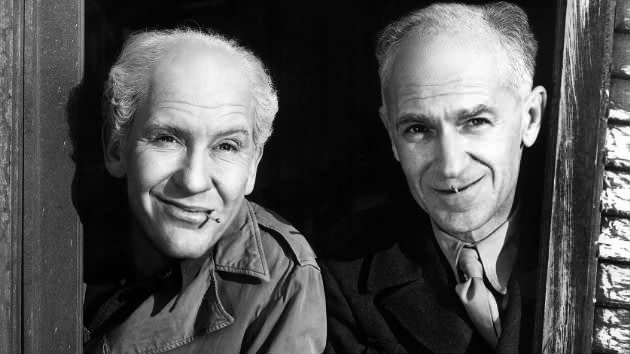 Movie Talk
Movie TalkG.I. Joe Five Facts: The Evolution of Joe

If you're a guy who grew up in the '80s, chances are your childhood just wouldn't have been the same without G.I. Joe. Whether it was the comics, the Hasbro toy line, or the after-school cartoon, G.I. Joe was there.
With "G.I. Joe: Retaliation" opening this weekend, and a whole new complementary line of toys, the Joes are having a renaissance of sorts. But the truth is, they never really went anywhere at all. In fact, the '80s version was a Joe renaissance in its own right.
To celebrate this staple of pop culture, this week's Five Facts looks at the history of G.I. Joe, from the very first time the name appeared to the '60s toy for which the term "action figure" was coined to today's big-budget blockbuster starring the Rock, Channing Tatum, and Bruce Willis.

What's in a Name?
1. The term "G.I. Joe" became widely used in World War II to describe any member of the United States armed forces, primarily enlisted soldiers. The origin of the name stems from "G.I.," the abbreviation for "government issue," which described pretty much any article federally distributed for military use. However, the meaning behind that abbreviation actually comes from the U.S. Army bookkeeping abbreviation for "galvanized iron," which was what standard-issue trash cans were made of.
The "Joe" part comes from cartoonist David Breger, who wrote and illustrated the popular wartime 'toon "Private Breger Abroad" for the Saturday Evening Post. In early 1942, Yank: The Army Weekly wanted Breger to write a similar cartoon but with a different name. Breger changed his starring soldier from Private Breger to Joe Trooper; then, after noticing how many items around the barracks were stamped "G.I.," he dubbed the character G.I. Joe.

G.I. Joe Goes to Hollywood
2. Thanks to the popularity of Breger's cartoon, the term "G.I. Joe" became part of every soldier's vernacular. But the term really took off after Robert Mitchum and Burgess Meredith starred in William Wellman's "Story of G.I. Joe" in 1945. The film tells the story of the Pulitzer Prize-winning, boots-on-the-ground war correspondent Ernie Pyle, one of the most respected reporters ever. Pyle effectively brought the war home to millions by communicating the hardships and triumphs of the common foot soldier: the G.I. Some 60 years after Pyle tragically lost his life in the Pacific theater, Hasbro honored Pyle with his very own action figure, part of the G.I. Joe D-Day collection.
Don't Call It a Doll
3. Of course, where would G.I. Joe be without Hasbro? After seeing the success of Mattel's Barbie doll and her multiple accessories, Hasbro realized that it could profit from a male equivalent. It tasked Marketing and Development Director Don Levine with designing one. While walking past an art store window one day, Levine saw a wooden mannequin and had a vision that would change the toy world forever: "Suddenly it occurred to me that we could create something truly magnificent if there was a way to produce figures that moved and posed any which way the human body did." Soon after, in 1964, the action figure, with "19 points of articulation," was born. And to make that name stick, Hasbro's president, Merrill Hassenfield, threatened to stop shipping product to any sales rep who called it a doll.
The Rise of Cobra
4. Despite cutting-edge developments like the Kung Fu Grip, the 12-inch line of G.I. Joes was discontinued in 1978. But in 1982, thanks in no small part to the popularity of "Star Wars" action figures, Hasbro relaunched Joe, while downsizing from 12 inches to 3.75 inches. Hasbro also introduced an enemy for the first time: the global terrorist organization known as Cobra. Combine that with the must-see after-school cartoon "G.I. Joe: A Real American Hero" and a Marvel comic book series, and Joe yet again found himself on top of the world.
Channing All Over Your Joe
5. Which brings us to today, the opening weekend for "G.I. Joe: Retaliation," the sequel to the global hit "G.I. Joe: The Rise of Cobra." "Retaliation" coincides with a new Hasbro product line featuring miniature, 3.75-inch, and 12-inch action figures, as well as a ton of other cool stuff that would make the original G.I. Joe's head spin. The new toys also feature lifelike resemblances to the characters played by the Rock, Channing Tatum, Bruce Willis and others. Since we like to compare now with then, we put together the gallery above, showing the actors from the two Joe films with the character art from the '80s action figures they portray.
[Related: Get local tickets and showtimes for "G.I. Joe: Retaliation"]
And if you're wondering how the film can possibly live up to childhood expectations, well, we asked the cast precisely that in the video below...
Follow me on Twitter (@Adpoc)

 Yahoo Movies
Yahoo Movies 